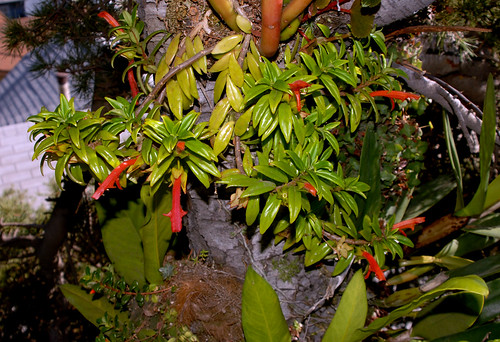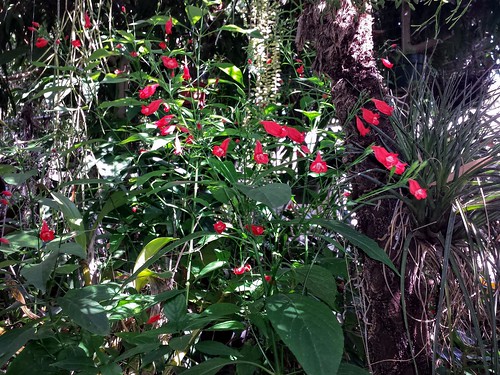They have a trade coming up this Saturday and I've been trying to prioritize which plants to share. So far I've posted that I have seeds of Echeveria coccinea available...
Here are some other seeds or cuttings that I should share...
Columnea Elmer Lorenz seeds
Not sure what its "real" name is... maybe it's Columnea crassifolia? The leaves are certainly very succulent... for a Columnea. My plant mentor Elmer Lorenz gave it to me several years ago and I've been really happy with it. This epiphyte is exceptional because it stays in bloom for almost the entire year. My friend Dave says the same is true of Columnea schiedeana. I wonder which one would grow the best epiphytically.
Anthurium scandens (xeric form) seeds
This epiphyte is the winner of the 2011 Epiphyte Grand Prix. The flowers aren't showy but it does make nice clusters of purplish fruits.
Epiphytic Kalanchoe cuttings (bundle)
Here's what would be included in the bundle...- Kalanchoe ‘Orangery’ (K. manginii × K. jongmansii)
- Kalanchoe schizophylla (hemiepiphyte)
- Kalanchoe 'Tessa' (K. gracilipes x K. manginii)
- Kalanchoe uniflora (my favorite)
Mixed succulent seeds
I have lots of different succulents, mostly in the Crassulaceae family, happily growing on my tree. For example...I'm guessing that this little succulent is Echeveria minima. The seeds from this succulent, and from several other ones growing on my tree, will be included in this mix.
Mixed Tillandsia seeds
The seeds from various Tillandsias growing on my tree. Primarily from Tillandsia aeranthos but also from a few others such as ionantha...Reed-stem Epidendrum seeds
Most orchid seeds don't have enough nutrients to germinate on their own. In order to germinate in nature they depend on specific varieties of microscopic fungus to supply the necessary nutrients. My impression is that the seeds of some orchids, such as those of reed-stems, are an exception to the rule.Sowing Instructions
I sow all these seeds, except for the Tillandsia seeds, the same way. First I put some well-drained medium into a small pot. Then I add a layer of New Zealand Sphagnum moss on top. I sow the seeds on the moss, put the pots in zip lock bags and place them near a bright window or under grow lights.For the pots I use 500 ml water bottles. I cut the tops off, remove the labels and cut some drainage holes in the bottom. Three of these fit nicely in a gallon zip lock bag.
Usually I don't completely seal the bags, but this means that every so often I'll have to inspect them to make sure that pots aren't drying out too much. I think it's safer to err on the side of too dry rather than too moist. If the pots are too moist then they can start to get slimy.
I rarely ever sow one type of seed by itself. For example, when I sow the reed-stem seeds I'll include one or two seeds from Anthurium scandens in the pot. This helps me hedge my bets. Using small pots also helps to hedge bets. It's important to avoid putting too many eggs in one basket. For example, my friend had several different nice plants in a terrarium. They were all wiped out when she introduced a new plant. Putting three small pots in one bag helps to limit the spread of pathogens.
I also hedge my bets by using different medium mixes. Mixes include different combinations of...
- peat
- perlite
- pumice
- small bark
For the Tillandsia seeds I usually sow them directly on suitably sized branches which I'll soak at night 3-4 times per week.
Seed Sowing Logic
The point of growing plants from seed is select for trait combinations which are the most closely suited to your conditions. Seeds are all different, which means that they won't all prefer the same exact conditions. Some seeds will be better suited to your conditions than others. Plus, seeds won't be equally tolerant of heat or cold or dryness. All progress with plants depends on growing them from seed.Updates
While I'm at it, here are some recent pics of the plants growing on my Cedar tree...
Meiracyllium trinasutum pretending to be an Encyclia (nematocaulon). Also in the photo is Tillandsia albertiana and Microgramma vacciniifolia.
This Tillandsia aeranthos volunteer looks a little different... like it's more star-shaped or something. Looks similar to this one.
This looks like a seedling of Cotyledon orbiculata.... but I don't remember sowing any of these seeds on the tree.
This Crassula pruinosa isn't the most exciting, and this photo isn't so great, but I'm happy with this little dangling succulent. It has earned some attention.
Several years ago Elmer gave me several seedlings of Anthurium coriaceum. I shared several with my friends and put a few on my tree. Mine grew so much slower than my friends'. Well yeah, they put theirs in pots! But I'm happy to see that the new leaf on this one is significantly larger than the older leaves.
This is Lemmaphyllum microphyllum, a miniature fern from Japan, growing on a big bunch of New Zealand Spahgnum moss around three stories up on my tree. The fern hasn't managed to escape from the moss, but a different variety of moss is trying to....
The challenge is that the bark isn't very good at storing water. Here you can see the fern in context...
The orange flowers are from Columnea Elmer Lorenz. I wish that I had attached it to a horizontal branch instead.
Further up on the tree I noticed that my clump of plants growing all over Aglaomorpha coronans had been dislodged by some critter. It didn't help that a nice, but heavy, Echeveria gibbiflora was pulling down on the clump. Here's a picture that I took last year of the Echeveria...
This Echeveria, which grew from seed that I had sown on the tree, is different from the other seedlings because its leaves are more rounded and the plant itself branches. None of the numerous other seedlings have branched. I really like the idea of a branching gibbiflora so I decided to cut this one off in order to give it more TLC than it has been receiving. Here's the pic I took after removing it...
And here's a pic of it with a one gallon pot for reference...
How awesome would it be to have an Echeveria that branches just as much as a Jade plant?
Lastly, here's a context pic of Anthurium scandens....
In retrospect, Columnea Elmer Lorenz should have been a contestant in the 2011 Epiphyte Grand Prix. How different would the tree look?
I water the entire tree twice a week at night during the summer. When the weather starts to get cooler, I water less and less frequently and earlier and earlier in the day.
Every tree in California should have at least a few plants growing on it!


























